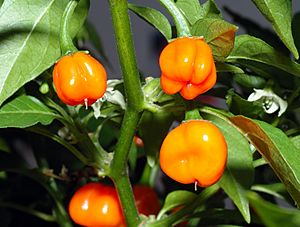Capsicum chinense facts for kids
Quick facts for kids Capsicum chinense |
|
|---|---|
 |
|
| Habanero fruits | |
| Scientific classification | |
| Genus: |
Capsicum
|
| Species: |
chinense
|
| Synonyms | |
|
|
Capsicum chinense is a type of chili pepper plant. It's often called a "habanero-type pepper." These peppers originally come from the Americas.
C. chinense peppers are famous for their amazing flavors. Many of them are also incredibly hot! In fact, some of the hottest peppers in the world belong to this group. They can score over 2 million on the Scoville scale, which measures how spicy a pepper is.
Scientists sometimes group C. chinense with another pepper type called C. annuum. But you can often tell them apart by their flowers. C. chinense plants usually have two to five flowers or fruits at each spot on the stem. C. annuum plants usually have only one. These two types of peppers can also mix and create new kinds of peppers. Many believe that C. frutescens is the ancestor of C. chinense.
Contents
Why is it called "Chinese Pepper"?
The scientific name C. chinense means "Chinese capsicum." But this name is a bit of a mistake! All Capsicum peppers actually started in the Americas.
A Dutch scientist named Nikolaus Joseph von Jacquin gave it this name in 1776. He thought the peppers came from China. This was because European explorers had brought them to China, and they became very popular there.
What Do C. chinense Plants Look Like?
C. chinense plants can look very different from one another. For example, the well-known Habanero pepper plant grows into a small, bushy plant. It's usually about 0.5 meters (about 1.6 feet) tall.
Like most pepper plants, their flowers are small and white. They have five petals. When the plant grows fruit, the peppers come in many colors and shapes. Red, orange, and yellow are the most common colors when they are ripe. But you can also find brown and purple ones! These plants also have shallow roots, which is common for peppers.
Where Do These Peppers Grow?
It's a bit tricky to say exactly where C. chinense first came from. However, many studies suggest it started in the tropical northern Amazon region. This area stretches from Southern Brazil to Bolivia.
Later, these peppers traveled to the Caribbean islands and Cuba. This is how the name Habanero came about, meaning "from Habana" (Havana, Cuba). Many peppers of this type were shipped out from Havana's port. Even though they are named after Havana, very spicy peppers like habaneros are not often used in traditional Cuban cooking.
In warm places, C. chinense plants can live for several years. But in cooler climates, they usually don't survive the winter. However, new plants can easily grow from seeds left from the year before.
How Have People Used C. chinense?
People have been growing and eating C. chinense peppers for thousands of years. Seeds of these peppers have been found in caves in Central America. This shows that people were eating them as far back as 7,000 B.C.
In Eastern Mexico, dried peppers and seeds have been found in ancient burial sites. These are about 9,000 years old! This also points to their use around 7,000 B.C. It's thought that people started growing these peppers on purpose about 10,000 to 12,000 years ago in Central-East Mexico.
For a long time, these peppers were only found in the Americas. But about 400-500 years ago, they spread to other parts of the world. This happened after the Columbian Exchange, when goods and ideas were shared between the Americas and Europe. As they grew in new places like Asia and Africa, new types of C. chinense peppers developed.
Many gardeners also love C. chinense peppers. They grow them for their bright, beautiful colors and for their tasty fruit.
How Are C. chinense Peppers Used in Cooking?
For thousands of years, C. chinense peppers have been a key ingredient in cooking from Yucatán and the Caribbean. They add a lot of heat to traditional dishes. People mainly use them in stews, sauces, and to marinate meats and chicken.
Sometimes, American food also uses these peppers. For example, Habanero peppers are a group of C. chinense varieties. They are often used in hot sauces and very spicy salsas. This is because Tex-Mex and Mexican cuisine are very popular in American culture.
Popular C. chinense Varieties
Just like C. annuum, C. chinense has many different varieties. Here are some common ones:
- 7-Pot chili (Trinidad)
- 7-Pot Primo (Louisiana)
- Adjuma (Suriname)
- Ají chombo (Panama)
- Ají dulce (Cuba, Dominican Republic, Puerto Rico, Venezuela) - a type that isn't spicy
- Arriba Saia (Brazil)
- Datil (Florida)
- Fatalii (south central Africa)
- Habanero chile (Caribbean, Central America and Mexico)
- Carolina Reaper (South Carolina)
- 'Red Savina' Habanero
- Cabai ceremai (Indonesia)
- Hainan yellow lantern chili (Hainan Island, South China)
- 'Madame Jeanette' (Suriname)
- Bhut jolokia (Assam)
- 'Dorset' Naga pepper (a Bhut jolokia type)
- Scotch bonnet (Jamaica, Trinidad)
- Trinidad scorpion (Trinidad)
- Jamaican Hot Chocolate
- Kambuzi pepper, Malawian pepper
- Cabik geronong (Sarawak, Malaysia)
- Nayi Miris නයි මිරිස් (Sri Lanka)
See also
 In Spanish: Capsicum chinense para niños
In Spanish: Capsicum chinense para niños


